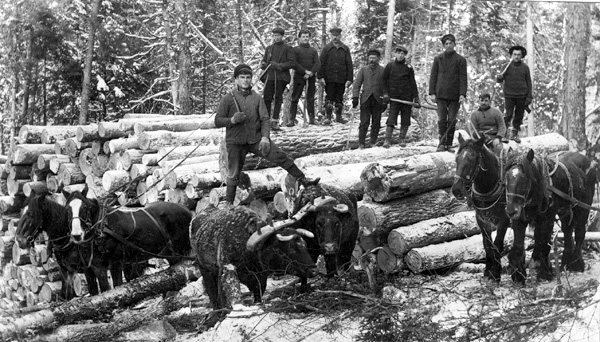 |
March 15, 2002
Horse Logging: Yesterday and Today
|
Using single horses, or teams of horses, was fundamental to the logging
industry from the early 1800s well into he 1930s when trains, trucks and other
mechanical vehicles took away most of their usefulness. In the early days each
logging camp had its stable of horses and teamsters to drive them, while
skidding logs from the bush to the skidway, waiting for frozen ground to take
heavy loads to the water’s edge for the river run in the spring. When the long
mid-winter log runs to the water’s edge took place, numerous sleighs— built
by the camp carpenter and blacksmith—were put into use. Local farmers and
their farm teams were hired to come in to help. It should be mentioned that oxen
were used from early times and well beyond the turn of the century, until horses
took over almost completely waiting for the mechanization era to arrive. The
photo shows a team of oxen working with horses at the William Foster operation
at Fossmill in Chisholm Township in the 1910s.
 |
|
|
Oxen hauling logs at Bill Foster’s Fossmill
operation, Circa 1915. |
|
Farmers and wood lot owners have used horses to skid fuel wood
and saw logs for personal use or sale for decades. Recently, professional horse
loggers have established businesses providing logging services to private and
corporate customers. With today’s emphasis on environmental protection, many
private land owners prefer the minimal damage to the forest caused by horses
compared to mechanized logging. In some cases, horse loggers are hired because
of the reduced noise factor near urban areas, and in some cases because the job
is too small for other logging companies. Tembec, with its excellent
environmental program, supports and encourages horse logging as do other
companies that buy quality logs.
Horse Logger Art Shannon
My son recently attended a workshop in Toronto on Woodlot
Management, where several horse loggers offered their services. One of them was
Art Shannon, who worked in the North Bay area a few years ago and now works out
of Lindsay, Ontario. His company Arbour North has an interesting website (www3.sympatico.ca/art.shannon) which features logging photos, horse logging
courses, cedar rails and posts, etc. for sale, and has numerous interesting
links like the Eastern Ontario Model Forest Association.
In the fall of 1995 the Nugget reported on Art logging Bill and
Carrie Steer’s property in Mattewan Township (see photo). Tembec marked the
trees and provided a detailed plan. Art did the work and Tembec bought the logs.
The Steers were looking to attract deer and to encourage better species to grow.
Horse Logger Gerald Cook
At the forestry expo in Mattawa in September, I met horse logger
Gerald Cook from Bracebridge. While surfing the net looking for horse logging
references, I ran across an excellent article with photos on Gerald in the
October 2001 issue of the Journal of Logging and Sawmilling on all aspects of
his operation (check www.forestnet.com ). By coincidence the article is written
by Ray Ford, the award-winning Chisholm Township writer. Reference is also made
to Art Shannon in the article.
Gerald sent me some photos of his operation. (see below) He points out that it takes some skill to stay in the business, and
many have tried and not made it. Gerald usually works on small high quality
lots, and usually has an annual Crown Land allocation. The Cooks also thin
plantations and cut shelterwood to thin and improve woodlots. He sells his logs
to Tembec in Huntsville and sometimes cuts directly for Tembec on contract.
 |
Gerald Cook thinning a plantation with his horses.
(Gerald Cook photos) |
 |
|
Gerald skids the logs the shortest possible distance with his
horses, and his son loads them on a trailer with their tractor and hauls them to
a location where the buyer picks them up. For the last three years, the Cooks
have demonstrated horse logging at the Parry Sound Logging Days. Call him for
further information (705) 645-8360.
Horse Logger Pat Kilroy
Many people in the North Bay area have horses, including Pat
Kilroy who lives east of Powassan and does some occasional horse logging. He
worked with Art Shannon setting up Art’s horse logging course at Sir Sanford
Fleming College in Peterborough. Pat has done some plantation thinning in
Boulter Township for the MNR and is currently improving a local bush. He has had
oxen in the past, and is involved with various horse owners who get together
regularly to share their experience. The next meeting will be in South Himsworth
in the spring. Pat can be contacted at (705) 724-2445.
Heritage Perspective Home Page
|

![]() Past
Forward is now on Facebook "LIKE" us to keep in touch
Past
Forward is now on Facebook "LIKE" us to keep in touch